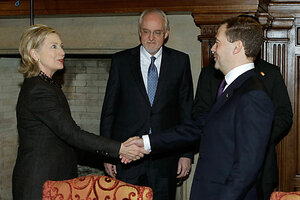Nuclear weapons reduction: US, Russia close to announcing deal
The nuclear weapons deal would replace the START accord of 1991. The apparent agreement comes just ahead of a White House summit on nuclear security in April.

Russian President Dmitry Medvedev, shakes hands with Secretary of State Hillary Rodham Clinton during a meeting in Moscow, March 19. American and Russian negotiators reached an agreement Wednesday, that reduce the world’s two largest arsenals of nuclear weapons.
Vladimir Rodionov/Presidential Press Service/AP
Washington
American and Russian negotiators reached agreement Wednesday on a new strategic arms reduction treaty that will continue the process of reducing the world’s two largest arsenals of nuclear weapons – and that will move the powers further away from their 20th-century status as cold-war enemies.
Agreement comes just as the Obama administration is about to embark on several weeks of nuclear diplomacy. President Obama has invited more than 40 heads of state to a White House summit on nuclear security in April, and a Nuclear Non-Proliferation Treaty (NPT) review conference is set for May.
Official announcement could come as early as Friday of agreement on a follow-on Strategic Arms Reduction Treaty to replace the original START accord of 1991, US officials say. Russian officials in Moscow announced earlier Wednesday that all but a few details in the treaty’s annex have been agreed on. That clears the way for a signing of the new treaty in Prague, the Czech Republic capital where Mr. Obama laid out a vision of “a world without nuclear weapons” nearly a year ago.
Announcement of an accord was anticipated. The two sides had hoped to reach agreement before expiration of the original START on Dec. 5. But failure to quickly see eye to eye on the treaty’s toughest issues – including, for the Russians, the degree of obtrusive verification measures – put agreement beyond the original deadline.
As recently as last week, Secretary of State Hillary Rodham Clinton said during a trip to Moscow that negotiations were making substantial progress and that a conclusion was anticipated “soon.”
The accord is expected to include the deal that Obama and Russian President Dmitry Medvedev concluded with a handshake last July to reduce each country’s nuclear warheads to between 1,500 and 1,675 within seven years. The original START accord, reached by US President George H.W. Bush and Soviet President Mikhail Gorbachev, called for reducing arsenals to about 6,000 warheads each and included verification measures to boost confidence on each side that the other was following through on obligations.
“This agreement gives a boost to the administration’s nuclear efforts in at least three respects,” says Steven Pifer, an arms-control expert at the Brookings Institution in Washington who served on past US delegations to nuclear-force reduction talks. “When Obama holds his nuclear-security summit he can say, ‘We and the Russians are doing our part. Now let’s figure out how this group can do its part to safeguard nuclear materials.’ ”
The new START may be even more crucial to the May NPT review conference, Mr. Pifer says, because it will strengthen the hand of US officials seeking to dissuade nuclear wannabes from pursuing nuclear weapons. “It just puts more impediments on the road to developing nuclear weapons,” he says.
Finally, Pifer says, the accord is a “validation” for the Russians that they are still a superpower, at least in the nuclear realm. And that could leave the Russians more open to cooperation with the US – or that’s what the administration hopes, he says.
“Since last year, the administration has put this [START] accord in the context of improving relations with Russia, and specifically of getting the Russians to join in putting more pressure on Iran over its nuclear program,” he says. “They haven’t gotten quite as much so far as they had envisioned, but I think the hope is still there.”
